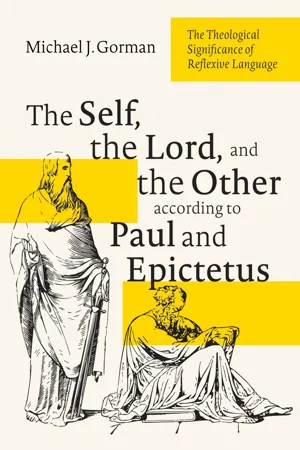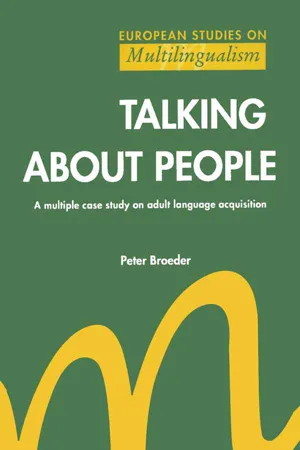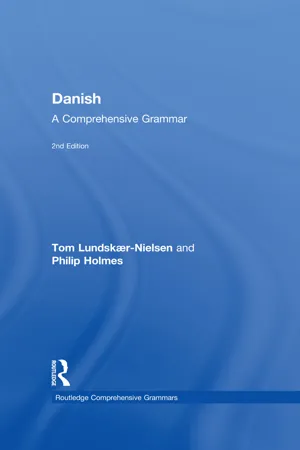Languages & Linguistics
Possessive Pronouns
Possessive pronouns are a type of pronoun that indicate ownership or possession. They replace a noun and show who or what something belongs to. Examples of possessive pronouns include "mine," "yours," "his," "hers," "ours," and "theirs." These pronouns are used to avoid repetition and make sentences more concise.
Written by Perlego with AI-assistance
Related key terms
Related key terms
1 of 4
Related key terms
1 of 3
8 Key excerpts on "Possessive Pronouns"
- eBook - ePub
Icelandic
An Essential Grammar
- Daisy L. Neijmann(Author)
- 2021(Publication Date)
- Routledge(Publisher)
it”).- Possessive pronouns specify who or what someone or something belongs to (“My coat is good but I like yours better”; “His long hair is gone”).
- Reflexive pronouns typically reflect the action expressed by a verb back onto the subject of the sentence (“The dog washes itself in the river” [the dog = itself]; “They introduced themselves” [they = themselves]).
- Demonstrative pronouns point towards the noun they replace, in space, time or distance, or to indicate specific alternatives (“Not this but that”).
- Interrogative pronouns are used to ask about someone or something (“Who is this?”, “What are you doing?”, “Whom are you buying this for?”).
- Reciprocal pronouns carry the idea of “each other” or “one another” (“They could not stand each other”).
- Indefinite pronouns are used when we cannot define someone or something precisely (“I saw someone doing something to that car”; “Some like it hot”). Among these are pronouns that specifically pertain to a duality (dual pronouns; e.g., both) while others indicate an unspecified plurality (i.e., more than two: plural pronouns, such as Some in the example above).
- Negative pronouns refer to a negative noun phrase and indicate the non-existence of people or things (“No-one was here today and so nothing could be accomplished”).
- Relative pronouns begin a so-called relative clause, that is, a dependent clause most often used to define or identify the noun that precedes it (see also Chapter 14 ). Examples: “The teacher who taught us today is not the teacher who also directs the school choir ”.
- Dummy pronouns fill in an empty slot in a clause but do not have a meaning of their own.
8.2 Personal pronouns
In Icelandic, as in English, personal pronouns inflect for number, person and gender – and, of course, case. The third person singular also has three different gender forms; in Icelandic, unlike in English, the third person plural - Jan McAllister, James E. Miller(Authors)
- 2013(Publication Date)
- Wiley-Blackwell(Publisher)
Table 5.5 .Table 5.5 Possessive Pronouns (pronoun use – see text)Number Person Singular Plural First person Mine Ours Second person Yours Yours Third person His, hers Theirs To continue our analysis of (12), if John's in (12a) is a possessive noun, and by virtue of this we call the substituted form his in (12b) a possessive pronoun, what about his in (12d)? This form also substitutes for John's in (12c), a possessive noun, so presumably we should call this token of his a possessive pronoun as well, and indeed, this is the traditional label that would be applied to his in both (12b) and (12d). Now consider (13).13.a. That Ferrari is mine.b. * That Ferrari is my.c. My red Ferrari is fantastic.d. * Mine red Ferrari is fantastic.In traditional grammars, and indeed in some clinical resources such as the STASS and DASS, in (13) both mine and my would be labelled Possessive Pronouns, just like his in (12). How do we explain the ungrammaticality of (13b) and (13d)? Look back at examples (6) and (7), which illustrated the way that substitution could be used to identify the part of speech of this in (6a) I like this book . The fact that we could substitute unambiguous determiners the and their in (6b) I like the book and (6c) I like their book led us to conclude that this was a determiner in (6a). So by the same criterion, in both (14a) and (14b), his should be a determiner.14.a. I like his book.b. I like his Ferrari.So one approach seems to call my, your, his, etc. determiners, and the other calls them pronouns. How do we resolve these conflicting labels? The compromise that is sometimes adopted (see Further Reading) is to call all the forms in Table 5.5 , plus my, your, his, her, its, our and their ‘possessives’ and to identify two sub-groups based on function (according to the criterion of substitutability): the forms in Table 5.5 are possessives with the ‘pronoun function ’ or ‘independent function- eBook - ePub
- Collins Dictionaries(Author)
- 2016(Publication Date)
- Collins(Publisher)
Pronouns What is a pronoun? A pronoun is a word you use instead of a noun, when you do not need or want to name someone or something directly, for example, it , you , none . ➤ There are several different types of pronoun: ● Personal pronouns such as I, you, he, her and they, which are used to refer to you, the person you are talking to, or other people and things. They can be either subject pronouns ( I, you, he and so on) or object pronouns ( him, her, them, and so on). ● Possessive Pronouns like mine and yours, which show who someone or something belongs to. ● Indefinite pronouns like someone or nothing, which refer to people or things in a general way without saying exactly who or what they are. ● Relative pronouns like who , which or that, which link two parts of a sentence together. ● Interrogative pronouns like who , what or which, which are used in questions. ● Demonstrative pronouns like this or those, which point things or people out. ● Reflexive pronouns, a type of object pronoun that forms part of Spanish reflexive verbs like lavarse (meaning to wash ) or llamarse (meaning to be called ). ➪ For more information on Reflexive verbs , see page 91. ➤ Pronouns often stand in for a noun to save repeating it. I finished my homework and gave it to my teacher. Do you remember Jack? I saw him at the weekend. ➤ Word order with personal pronouns is usually different in Spanish and English.Passage contains an image
42 Pronouns Personal pronouns: subject What is a subject pronoun? A subject pronoun is a word such as I, he, she and they , that carries out the action expressed by the verb. Pronouns stand in for nouns when it is clear who or what is being talked about, for example, My brother isn’t here at the moment. He’ll be back in an hour. - eBook - ePub
- R. G. (Robert Gordon) Latham(Author)
- 2009(Publication Date)
- Perlego(Publisher)
a. Personal pronouns.b. Relative pronouns.c. Articles.The reflective pronoun often becomes reciprocal.§ 395 . These statements are made for the sake of illustrating, not of exhausting, the subject. It follows, however, as an inference from them, that the classification of pronouns is complicated. Even if we knew the original power and derivation of every form of every pronoun in a language, it would be far from an easy matter to determine therefrom the paradigm that they should take in grammar. To place a word according to its power in a late stage of language might confuse the study of an early stage. To say that because a word was once in a given class, it should always be so, would be to deny that in the present English they, these, and she are personal pronouns at all.The two tests, then, of the grammatical place of a pronoun, its present power and its original power, are often conflicting.§ 396 . In the English language the point of most importance in this department of grammar is the place of forms like mine and thine; in other words, of the forms in -n.Now, if we take up the common grammars of the English language as it is, we find, that, whilst my and thy are dealt with as genitive cases, mine and thine are considered adjectives. In the Anglo-Saxon grammars, however, min and þin, the older forms of mine and thine, are treated as genitives or possessives.§ 397 . This gives us two views of the words my and thy.a. They may be genitives or possessives, which were originally datives or accusatives; in which case they are deduced from the Anglo-Saxon mec and þec .b. They may be the Anglo-Saxon min and þin, minus the final -n.Each of these views has respectable supporters. The former is decidedly preferred by the present writer.§ 398 . What, however, are thine and mine? Are they adjectives like meus, tuus, and suus, or cases like mei, tui, sui, in Latin, and hi-s in English?It is no answer to say that sometimes they are one and sometimes the other. They were not so originally. They did not begin with meaning two things at once; on the contrary, they were either possessive cases, of which the power became subsequently adjectival, or adjectives, of which the power became subsequently possessive. - eBook - ePub
The Self, the Lord, and the Other according to Paul and Epictetus
The Theological Significance of Reflexive Language
- Michael J. Gorman(Author)
- 2023(Publication Date)
- Cascade Books(Publisher)
Since it is universally acknowledged that pronouns have very little inherent semantic weight or communicative dynamism, other factors such as context, situation, discourse purpose, and word order are very important to the interpretation of reflexives. Second, the use of reflexive pronouns can effect subtle distinctions in meaning. These distinctions vary from context to context, but it is generally true, according to Bíly, that the use of a reflexive pronoun where a personal pronoun could have been used increases the communicative dynamism, or semantic value, of the pronoun at that point. 177 Both Cantrall and Bíly agree that a reflexive indicator of possession is almost always emphatic. They, and others, perceive a fairly universal tendency to employ reflexive possessives in order to convey a variety of emphases, depending on the context. Cantrall finds that reflexives can convey the following: 1. distinction 2. independence 3. close association and protectiveness (emotional identification) 4. inalienable possession 5. subjective viewpoint. 178 Bíly lists similar categories of semantic features for which a reflexive possessive can be marked: 1. “non-sloppy” (i.e., unambiguous) identity 2. specificity 3. emotional, social, or temporal proximity 4. inalienability. 179 Although it is not always clear that a Greek reflexive possessive is emphatic, these categories are helpful for understanding specific possessive reflexive texts that do seem to be emphatic. 4. Summary: Interpreting Reflexive Pronominalization It is difficult to take general theories and studies based on other languages and apply them to reflexive pronominalization in Greek. Nevertheless, the preceding discussion provides at least two general principles for the interpretation of reflexive pronoun constructions: 1)Like other pronouns, reflexive pronouns inherently possess little semantic value and often occur out of syntactical necessity - eBook - ePub
Analyzing the Grammar of English
Third Edition
- Richard V. Teschner(Author)
- 2007(Publication Date)
- Georgetown University Press(Publisher)
possessive pronoun behaves in a coreferentially pronominal fashion, replacing and referring back to a noun or noun phrase:Figure 5d The English Personal Pronoun System[28] Sandy lost her coat yesterday, and I lost mine on Sunday.THE MORPHOLOGY OF PERSONAL PRONOUNS
Even a quick glance at the personal pronoun chart we have just presented will show that case cannot always be determined by form alone. Thus the form you is either subject or object, as is it and two of the three third person singular possessives, which can function as determiners or pronouns alike; likewise, her is either an object or a possessive determiner according to context (object:I saw her today;possessive determiner: I saw her mother today) .Of the twenty-five distinct personal pronoun forms filling forty separate slots in figure 5d, you is the most ubiquitous, filling four slots: 2.sg./2.pl. subject and 2.sg./2.pl. object. This morphofunctional underdistinctiveness has prompted a wide variety of popular spoken forms in the 2.pl. slots (both subject and object) in American English—the regional you-all and y’all (not to be confused with you’ll ’you will’), you’ns (/júə nz/, from you ones), yous (/jΛz/), youse (/jus/), youse guys , and the far less stigmatized you guys (applied to men and women alike)—and also in British (chiefly you lot) .Morphologically, possessive determiners can be distinguished from Possessive Pronouns by the word-final /s / in all but one instance (1.sg.). The rule for converting a possessive determiner into a possessive pronoun is this: to all determiner forms except my , add /s/ to make the pronoun equivalent unless an /s/ ends the form already (as it does in his and its) - eBook - ePub
- Peter Broeder(Author)
- 2013(Publication Date)
- Taylor & Francis(Publisher)
Subject and object pronouns are non-relational terms, i.e. they denote one entity, whereas Possessive Pronouns are relational terms, i.e. they denote a possessive relation between entities. Furthermore, possessive forms generally contain more information than subject or object forms in that they preserve the information of person and number encoded by the subject or object forms and, in addition, contain information about the possessive relation. This, all other things being equal, makes the possessive level more complex than the subject or object levels.In addition to this, subject forms rather than object forms are promoted by the interaction between pronominalization, grammatical subject/object, and given/new information. Thus, the subject NP is often used to maintain reference to a topic (e.g. a person, an object, a concept), while the VP is used to convey new and focussed information. As a result, the following predictions can be formulated with respect to the order of acquisition:P7 Subject forms are acquired before object formsP8 Subject forms are acquired before possessive formsP9 Forms in object function are acquired before forms in possessive functionTable 4.3 shows that subject pronouns are used much more frequently by native speakers of Dutch than object and Possessive Pronouns. This underlines the validity of predictions 7 and 8. A rather diffuse picture emerges for the relative frequency of the pronouns in object function vs. those in possessive function. There are differences between 1st role and 2nd role pronouns, between the informants, and between the internal and external corpus. As a result, frequency of use does not underline prediction 9.4.2.7
DEMONSTRATIVESIn many languages there is a close relationship between the sets of personal and Possessive Pronouns and the set of demonstrative pronouns. Table 4.6 - eBook - ePub
- Tom Lundskaer-Nielsen, Philip Holmes(Authors)
- 2015(Publication Date)
- Routledge(Publisher)
Pronouns4.1 Personal pronouns4.1.1 Personal, reflexive and Possessive Pronouns – forms, table
Singular Subjective case Objective case Reflexive pronouns Possessive Pronouns 1st person jeg mig mig min/mit/mine I me myself my, mine 2nd person du dig dig din/dit/dine - informal you you yourself your, yours 2nd person De Dem Dem Deres - formal you you yourself your, yours 3rd person han ham sig hans/sin - masculine he him himself his 3rd person hun hende sig hendes/sin - feminine she her herself her 3rd person den den sig dens/sin - common gender it it itself its 3rd person det det sig dets/sin - neuter it it itself its Plural 1st person vi os os vores (vor/vort/vore) we us ourselves our, ours 2nd person I jer jer jeres - informal you you yourselves your, yours 2nd person De Dem Dem Deres - formal you you yourselves your, yours 3rd person de dem sig deres they them themselves their, theirs Note – The 2nd person pronouns I, De, Dem, Deres are always written with a capital letter to distinguish them from the preposition i (in) and the 3rd person plural pronouns, respectively.4.1.2 Function and reference of personal pronouns
4.1.2.1 Function
As in English, the main function of personal pronouns is to replace nouns or noun phrases:Lise hjalp den gamle mand. Lise helped the old man. Hun hjalp ham. She helped him. The neuter pronoun det can also replace infinitives and clauses (see 4.2.4).4.1.2.2 Reference
- (a) When personal pronouns replace nouns/noun phrases, they represent or refer to the latter. There are three main types of reference: anaphoric, cataphoric and deictic.
- 1 Pronouns have anaphoric reference when they refer to a previously mentioned noun/noun phrase. Thus han refers back to the noun drengen in: Drengen tændte for fjernsynet, da han kom hjem. The boy turned on the television when he came home. This is by far the most common type of reference.
- 2 Pronouns have cataphoric reference when they refer to a following noun/noun phrase. Thus hun refers to the following noun phrase den gamle dame in: Hun er virkelig rar, den gamle dame.
Index pages curate the most relevant extracts from our library of academic textbooks. They’ve been created using an in-house natural language model (NLM), each adding context and meaning to key research topics.
Explore more topic indexes
Explore more topic indexes
1 of 6
Explore more topic indexes
1 of 4







